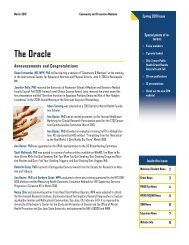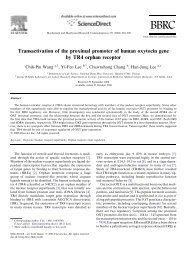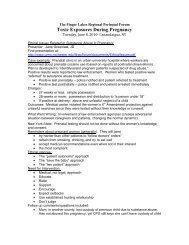Conservative Management of Pelvic Organ Prolapse
Conservative Management of Pelvic Organ Prolapse
Conservative Management of Pelvic Organ Prolapse
You also want an ePaper? Increase the reach of your titles
YUMPU automatically turns print PDFs into web optimized ePapers that Google loves.
678 Trowbridge and Fenner<br />
TABLE 4. Five-Point Rating Scale<br />
Grade Description<br />
0 No contraction<br />
1 Flicker, only with muscles stretched<br />
2 A weak squeeze, 2-second hold<br />
3 A fair squeeze with definite ‘‘lift’’ (in which<br />
the contraction can be felt to move in<br />
an upward direction)<br />
4 A good squeeze, good hold with lift<br />
(the contraction must be able to be<br />
repeated a few times)<br />
5 A strong squeeze, good lift, repeatable<br />
Modified from Sampselle 1990.<br />
Displacement <strong>of</strong> the examiner’s finger in an<br />
inward and upward direction into the vagina<br />
is also a physical finding likely to be associated<br />
with normal structural attachments <strong>of</strong><br />
the pelvic muscles as well as intact sensory<br />
and motor innervations. A patient who on<br />
repeat attempts is unable to perform a 1/5<br />
muscle contraction is likely a poor candidate<br />
for PMT and requires more intensive pelvic<br />
floor therapy such as transvaginal electrical<br />
stimulation therapy.<br />
TEACHING PELVIC MUSCLE EXERCISE<br />
Essential to the success <strong>of</strong> a program <strong>of</strong><br />
PMT is to assess the patient’s motivation<br />
in partaking in an exercise regimen because<br />
a minimum <strong>of</strong> 6 to 8 weeks <strong>of</strong> therapy will<br />
be necessary before improvement can be<br />
realized. Patients should be educated that<br />
pelvic muscle exercises are like other striated<br />
muscles <strong>of</strong> the body that can be trained.<br />
A multidiscipline approach will best tailor a<br />
patient’s needs in achieving their therapy<br />
goals.<br />
Assisting women in isolating the target<br />
muscles is the most important task in teaching<br />
pelvic muscle exercise (popularly<br />
known as Kegels). Approximately 19% to<br />
31% <strong>of</strong> women who believe they to perform<br />
Kegels actually perform them correctly. 23<br />
Teaching women to isolate these muscles<br />
successfully can be done at the time <strong>of</strong> a pelvic<br />
examination. The patient is asked to contract<br />
her muscles around the examiner’s<br />
fingers while the examiner takes note <strong>of</strong><br />
whether the patient is using auxiliary muscles<br />
(abdomen, gluteals, or thighs). A common<br />
mistake is that women will bear down when<br />
asked to perform a pelvic muscle contraction.<br />
Women will initially contract the outermost<br />
layer <strong>of</strong> the pelvic floor (bulbocavernosus<br />
and ischiocavernosus muscles) at which time<br />
they should be instructed to contract muscles<br />
at higher levels (levator ani). Patient<br />
should attempt this contraction multiple times,<br />
and once this is achieved, attempt to hold a<br />
contraction for 10 seconds. Patients who are<br />
having trouble isolating pelvic floor muscle<br />
might benefit from the care provider applying<br />
pressure on these muscles, being instructed<br />
on relaxing auxiliary muscles or using<br />
a set <strong>of</strong> weighted cones as an exercise<br />
aid. 24 A visual guide <strong>of</strong> the muscle layers<br />
involved in performing effective pelvic muscle<br />
contractions may be useful (Fig. 2). for<br />
some women to further understand the importance<br />
<strong>of</strong> contracting all the various layers<br />
<strong>of</strong> the pelvic floor muscles. Some women<br />
might also find it useful to use imagery in<br />
performing these exercises. The image is<br />
<strong>of</strong> the vagina pulling in and up toward the<br />
sacrum (like an elevator or cable car).<br />
PELVIC MUSCLE<br />
EXERCISE REGIMENS<br />
Various protocols are currently available;<br />
however, most experts would agree that 2<br />
components are crucial to success with<br />
PMT: 1) devoting a particular time to exercise,<br />
and 2) gradually increasing the amount<br />
or intensity <strong>of</strong> the exercise. This contradicts<br />
the generally held belief that women can<br />
perform Kegels anywhere and anytime. Initial<br />
recommendations proposed 30 to 80 pelvic<br />
muscle contractions per day. More recent<br />
protocols recommend a frequency <strong>of</strong> 30 per<br />
day with a greater emphasis on increasing<br />
the strength and intensity <strong>of</strong> the contraction.<br />
PATIENT EDUCATION AND<br />
LIFESTYLE MODIFICATIONS<br />
Patients with pelvic prolapse should be<br />
counseled on the importance <strong>of</strong> various

















